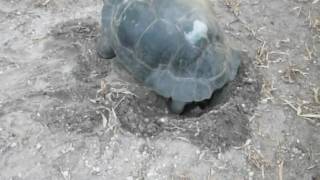Galapagos

The Galápagos tortoise or Galápagos giant tortoise (Geochelone nigra) is the largest living tortoise, native to seven islands of the Galápagos archipelago. Fully grown adults can weigh over 300 kilograms (661 lb) and measure 1.2 meters (4 ft) long. They are long-lived, with a life expectancy in the wild estimated to be 100–150 years. Populations have fallen dramatically due to hunting and the introduction of predators and grazers by humans since the seventeenth century. Now only ten subspecies of the original twelve exist in the wild. However, conservation efforts since the establishment of the Galápagos National Park and the Charles Darwin Foundation have met with success, and hundreds of captive-bred juveniles have been released back onto their home islands. They have become emblematic of the fauna of the Galápagos Islands.
Galapagos Videos
Galapagos Descriptions
Life Span
100 to 150 years
Size
Up to 48 Inches long and 661 lbs. when full grown
Food / Diet
The tortoises are herbivorous animals with a diet comprising cactus, grasses, leaves, vines, and fruit. Fruits such as the apple and mango are also treats to the tortise. Fresh young grass is a favorite food of the tortoises, and others are the 'poison apple' (Hippomane mancinella) (toxic to humans), the endemic guava (Psidium galapageium), the water fern (Azolla microphylla), and the bromeliad (Tillandsia insularis). Tortoises eat a large quantity of food when it is available at the expense of incomplete digestion.
By acquiring most of their moisture from the dew and sap in vegetation (particularly the Opuntia cactus), tortoises can go for long periods without actually drinking. They can also survive for over a year being forcefully deprived of all liquids, breaking down their body fat producing water as a side product.
The tortoise normally eat an average of 70~80 pounds (32~36 kg) a day.
Anatomy and Morphology
The tortoises have very large shells (carapace) made of bone. The bony plates of the shell are integral to the skeleton, fused with the ribs in a rigid protective structure.
Naturalist Charles Darwin remarked "These animals grow to an immense size … several so large that it required six or eight men to lift them from the ground." This is due to the phenomenon of island gigantism whereby in the absence of natural predation, the largest tortoises had a survival advantage and no disadvantage in fleeing or fending off predators.
When threatened, it can withdraw its head, neck and all forelimbs into its shell for protection, presenting a protected shield to a would-be predator. The legs have hard scales that also provide armour when withdrawn. Tortoises keep a characteristic scute pattern on their shell throughout life. These have annual growth bands but are not useful for aging as the outer layers are worn off. There is little variation in the dull-brown colour of the shell or scales.
Physical features (including shape of the shell) relate to the habitat of each of the subspecies. These differences were noted by Captain Porter even before Charles Darwin. Larger islands with more wet highlands such as Santa Cruz and the Alcedo Volcano on Isabela have lush vegetation near the ground. Tortoises here tend to have 'dome-back' shells. These animals have restricted upward head movement due to shorter necks, and also have shorter limbs. These are the heaviest and largest of the subspecies.
Smaller, drier islands such as Española and Pinta are inhabited by tortoises with 'saddleback' shells comprising a flatter carapace which is elevated above the neck and flared above the hind feet. Along with longer neck and limbs, this allows them to browse taller vegetation. On these drier islands the Galápagos Opuntia cactus (a major source of their fluids) has evolved a taller, tree-like form. This is evidence of an evolutionary arms race between progressively taller tortoises and correspondingly taller cacti. Saddlebacks are smaller in size than domebacks. They tend to have a yellowish color on lower mandible and throat. At one extreme, the Sierra Negra volcano population that inhabits southern Isabela Island has a very flattened "tabletop" shell. However, there is no saddleback/domeback dualism; tortoises can also be of 'intermediate' type with characteristics of both.
Sexual dimorphism is more apparent in the 'intermediate' and saddleback populations since males have more angled and higher front openings. Males also have a longer tail and a shorter and concave undershell and which has thickened knobs at the back edge, which facilitates mating. Male are larger than females: adult males weigh in at 272 to 317 kilograms (600 to 700 lb) females 136 to 181 kilograms (300 to 400 lb).
Range and habitat
The Galápagos tortoise is unique to the Galápagos Islands, a group of thirteen major islands and many smaller islets, all of volcanic origin lying west of Ecuador in South America.
Etymology and Taxonomic History
Galapagos Tortoise Distribution Map The shape of the carapace of some subspecies of the tortoises is said to have reminded the early Spanish explorers of a kind of saddle they called a "galápago," and for these saddle-shaped tortoises they named the archipelago. Up to 250,000 tortoises inhabited the islands when they were discovered. Today only about 15,000 are left.
There were probably twelve subspecies of Geochelone nigra in the Galápagos Islands, although some recognise up to 15 subspecies. Now only 11 subspecies remain, five on Isabela Island, and the other six on Santiago, Santa Cruz, San Cristóbal, Pinzón, Española and Pinta. Of these, the Pinta Island subspecies is extinct in the wild and is represented by a single individual. In the past, zoos took animals without knowing their island of origin. Production of fertile offspring from various pairings of tortoises largely confirmed that they are subspecies and not different species.
All the subspecies of giant tortoise evolved in Galápagos from a common ancestor that arrived from the mainland, floating on the ocean currents (the tortoises can drift for long periods of time as they are buoyant and can stretch head upwards to breathe). Only a single pregnant female or breeding pair needed to arrive in this way, and then survive, for Galápagos to be colonised. The closest living relative of the Galápagos giant tortoises is Geochelone chilensis, a small tortoise found in Argentina. The split between G. chilensis and the Galápagos lineage probably occurred 6-12 million years ago based on mitochondrial DNA analysis, before the origin of the oldest extant Galápagos island.
Espanola and San Cristobal, the oldest islands, were colonized first; this was followed by several migration events to and between other islands via local currents. The four named southern subspecies on the largest island, Isabela, are possibly not distinct genetic units, whereas a genetically distinct northernmost Isabela subspecies is probably the result of a separate colonization. Unexpectedly, the lone survivor of the abingdoni subspecies from Pinta Island ("Lonesome George") is very closely related to tortoises from San Cristobal and Espanola, the islands farthest from the island of Pinta. This informed breeding attempts more successful in the future as breeding had been attempted with Isabela Island populations.
It is thought that the saddle-backed type carapace evolved independently several times as a reaction to dry environments, although extinction of crucial populations by human activities confounds whether domed versus saddleback carapaces of different populations are mono- or polyphyletic.
Breeding
Mating occurs at any time of the year, although it does have seasonal peaks between January and August. When two mature males meet in the mating season they will face each other, rise up on their legs and stretch up their necks with their mouths open to assess dominance. Occasionally, head-biting occurs, but usually the shorter tortoise will back off, leaving the other to mate with the female. In groups of tortoises from mixed island populations, saddleback males have an advantage over domebacks.
The male sniffs the air when seeking a female, bellows loudly, and bobs his head. The male then rams the female with the front of his shell and bites her exposed legs until she withdraws them, immobilizing her. Copulation can last several hours with roaring vocalisations from the males. Their concave shell base allows males to mount the females from behind. It brings its tail which houses the penis into the female's cloaca.
After mating (June-December), the females journey up to several kilometres to reach nesting areas of dry, sandy ground (often near the coast). Nest digging can last from hours to days and is elaborate and exhausting. It is carried out blindly using only the hind legs to dig a 30 centimetres (12 in) deep hole, into which she lays up to sixteen hard-shelled eggs the size of tennis balls. The female makes a muddy plug for the nest hole out of soil mixed with urine and leaves the eggs to incubate. In rocky areas, the eggs are deposited randomly into cracks.
The young emerge from the nest after 120 to 140 days gestation later (December-April) and may weigh only 80 grams (2.8 oz) and measure 6 centimetres (2.4 in). Temperature plays a role in the sex of the hatchling: if the nest temperature is lower, more males will hatch; if it is high, more females will hatch. When the young tortoises emerge from their shells, they must dig their way to the surface, which can take up to a month. All have domed carapaces, and subspecies are indistinguishable. Galápagos Hawk used to be the only native predator of the tortoise hatchlings, as Darwin remarked: "The young tortoises, as soon as they are hatched, fall prey in great numbers to buzzards".
Sex can be determined only when the tortoise is 15 years old, and sexual maturity is reached at 20 to 25 years old. The tortoises grow slowly for about 40 years until they reach their full size. Reproductive prime is considered to be from the ages of 60–90.
Mutualism
Tortoises have a classic example of a mutualistic symbiotic relationship with some species of Galápagos finch. The finch hops in front of the tortoise to show that it is ready and the tortoise then raises itself up high on its legs and stretches out its neck so that the bird can pick off ticks that are hidden in the folds of the skin (especially on the rear legs, cloacal opening, neck, and skin between plastron and carapace), thus freeing the tortoise from harmful parasites and providing the finch with an easy meal. Other birds, including Galápagos Hawk and flycatchers, use tortoises as observation posts from which to sight their prey.
Galapagos Breeding Program
Mating occurs at any time of the year, although it does have seasonal peaks between January and August. When two mature males meet in the mating season they will face each other, rise up on their legs and stretch up their necks with their mouths open to assess dominance. Occasionally, head-biting occurs, but usually the shorter tortoise will back off, leaving the other to mate with the female. In groups of tortoises from mixed island populations, saddleback males have an advantage over domebacks.



















































.jpg)